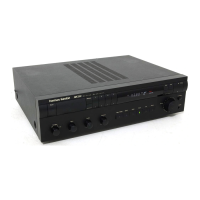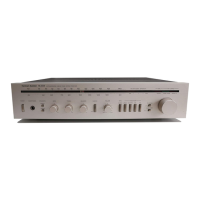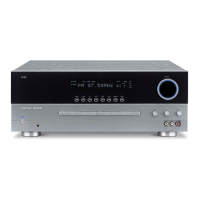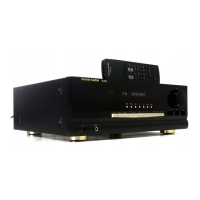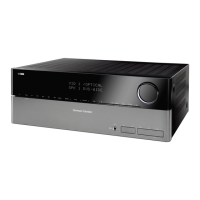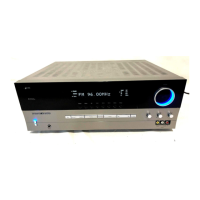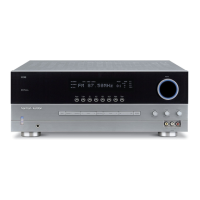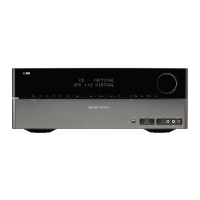Do you have a question about the Harman Kardon HK3390 and is the answer not in the manual?
Statement of compliance with technical standards for the product.
Explanation of formatting used in the manual for clarity.
Essential caution notices regarding electric shock and moisture.
Crucial warnings for safe operation and installation of the receiver.
Overview of the HK 3490/HK 3390's capabilities and design.
Key details regarding voltage, cabinet, cleaning, and unpacking.
Controls for powering the unit and indicators for its operational state.
Buttons to choose between different audio and video input sources.
Buttons for manual and preset tuning, AM/FM selection, and scan functions.
Controls for Bass, Treble, Balance, and Volume of audio output.
Features for display dimming, sleep timer, and information display.
Terminals for AM and FM antennas, and phono ground connection.
Ports for connecting audio/video sources and recorders.
Connections for main left/right speakers and secondary speaker sets.
Ports for remote sensors, external amplifiers, and AC power.
Inputs for digital audio sources and outputs for subwoofers.
Buttons for powering the unit on/off and selecting input sources.
Controls for tuning stations, managing presets, and scanning.
Buttons for playback, menu navigation, and source-specific functions.
Buttons for dimming, sleep timer, RDS, DSP, and other specific modes.
Guide to connecting audio sources like CD players, tape decks, and turntables.
Instructions for connecting main and secondary speaker sets.
Procedures for connecting external amplifiers and AC power.
Recommendations for optimal speaker positioning for listening enjoyment.
How to turn the unit on/off, select sources, and adjust basic settings.
Tuning stations, managing presets, and using RDS features for information.
Procedures for recording, memory backup, and processor reset.
Connecting and controlling an Apple iPod via The Bridge accessory.
Understanding how remote buttons function with different source devices.
Statement of compliance with technical standards for the product.
Explanation of formatting used in the manual for clarity.
Essential caution notices regarding electric shock and moisture.
Crucial warnings for safe operation and installation of the receiver.
Overview of the HK 3490/HK 3390's capabilities and design.
Key details regarding voltage, cabinet, cleaning, and unpacking.
Controls for powering the unit and indicators for its operational state.
Buttons to choose between different audio and video input sources.
Buttons for manual and preset tuning, AM/FM selection, and scan functions.
Controls for Bass, Treble, Balance, and Volume of audio output.
Features for display dimming, sleep timer, and information display.
Terminals for AM and FM antennas, and phono ground connection.
Ports for connecting audio/video sources and recorders.
Connections for main left/right speakers and secondary speaker sets.
Ports for remote sensors, external amplifiers, and AC power.
Inputs for digital audio sources and outputs for subwoofers.
Buttons for powering the unit on/off and selecting input sources.
Controls for tuning stations, managing presets, and scanning.
Buttons for playback, menu navigation, and source-specific functions.
Buttons for dimming, sleep timer, RDS, DSP, and other specific modes.
Guide to connecting audio sources like CD players, tape decks, and turntables.
Instructions for connecting main and secondary speaker sets.
Procedures for connecting external amplifiers and AC power.
Recommendations for optimal speaker positioning for listening enjoyment.
How to turn the unit on/off, select sources, and adjust basic settings.
Tuning stations, managing presets, and using RDS features for information.
Procedures for recording, memory backup, and processor reset.
Connecting and controlling an Apple iPod via The Bridge accessory.
Understanding how remote buttons function with different source devices.
| Total Harmonic Distortion | 0.07% |
|---|---|
| Input Sensitivity | 200 mV |
| Speaker Terminals | Binding posts |
| Speaker Load Impedance | 8 ohms |
| Power Output | 80 watts per channel into 8 ohms |
| Frequency Response | 10Hz to 100kHz |
| Tuner Section | FM/AM |
| Signal-to-Noise Ratio | 100dB (line) |
| AM Sensitivity | 500 µV/m |
| Inputs | 4 line-level inputs, 1 phono input |
